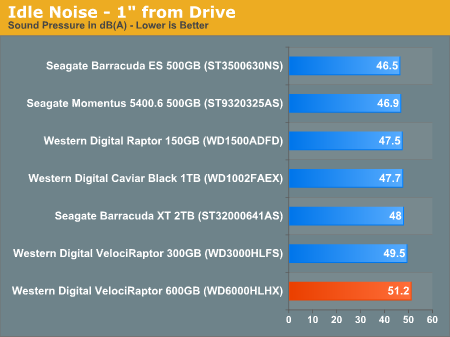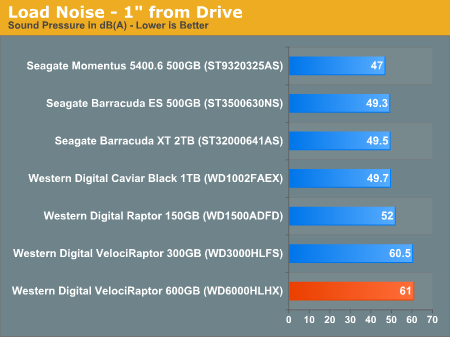Western Digital's New VelociRaptor VR200M: 10K RPM at 450GB and 600GB
by Anand Lal Shimpi on April 6, 2010 8:00 AM EST- Posted in
- Storage
Power Consumption
Western Digital promised that the new VelociRaptor would use no more power than its predecessor. To find out we measured the current going to the drive across all voltage rails and determined total power consumption at the drive level in both idle and while performing our 2MB sequential write test:

Power consumption did go up by 4.3% at idle, but hardly anything to complain about. More performance at roughly the same power isn't a bad thing. Do pay attention to how much more power the larger 3.5" drives consume. This isn't really an issue on the desktop, but in a server with tons of spindles it quickly adds up.

Load power is a similar story. The new drive uses a bit more than the old one, but still far less than any 7200 RPM 3.5" drive.
Noise
At 10,000 RPM these things are going to be louder than your standard 3.5" desktop hard drive. To find out how loud I put a sound meter 1" away from the front of the drive and measured pressure at both idle and while performing a torture 4K random write test. The torture test basically keeps the drive in constant seek mode so it's a good indication of how loud the drive will be when it's really crunching away.
Note that the system these drives are connected to is my standard SSD testbed, which is a fairly high end desktop that isn't optimized for noise. The decibel readings may be high (particularly because of the 1" distance they were taken at) but they will give you an accurate comparison of which drives will be the loudest.


Obviously these 10K RPM drives are loud when they're accessed. The new VR is not much louder than the old one, but compared to a newer 7200 RPM drive they are noticeably louder when seeking. At idle or when performing sequential operations the gap is far narrower, but under load it's pronounced. These drives have never been for silent PCs.










77 Comments
View All Comments
pjconoso - Thursday, April 8, 2010 - link
Maxtor's with Seagate, so there.ClagMaster - Tuesday, April 6, 2010 - link
These are good drives carrying on the Raptor tradition, but at the asking price at ~$0.60/Gb, way too pricy.I am going to wait next year for third generation SSD's at $0.50/Gb and 2-4x the current bandwidth before switching over.
leonsk - Tuesday, April 6, 2010 - link
Agree with Anand that SSD bor boot drive and 2 large HDs in RAID-1 is the most effective rig. What controller do you use? Or are you with software RAID?AstroGuardian - Wednesday, April 7, 2010 - link
Of course not mate. Software RAID is dead. I am sure he is using ICH10R's RAID controller.... Right Anand?bobbyto34 - Wednesday, April 7, 2010 - link
Hello,I have to change my primary hard drive (Samsung Spinpoint F1) because of some read failures...
I'm hesitating between a good ol' 1TB 7200 drive, an x-25M 160Gb or a new Velociraptor.
The computer will be used as music station with Sonar and sound banks. The current problem is that it's quite slow when loading those enormous sound banks with a 7200 drive.
I would like good performance in loading these sound banks, with silence because it's dedicated to music (and some gaming :p), and with reasonable disk space... For the moment, I can't see a good compromise with those 3 parameters. Am I wrong ?
slickr - Wednesday, April 7, 2010 - link
What the heck were you talking there buddy?You just buy 2 1TB HD and an SDD drive, to be faster. Do you know how much such configuration would put you back?
If not, go for the new raptor. Oh really, you just found out hot water. How about you mention its twice as cheap and even more to go for it, ten times more reliable than SSD's, and you can actually store 600gb, instead of 80gb of the intel ssd's or whatever for 250 dollars.
Compddd - Wednesday, April 7, 2010 - link
When will these start shipping?GullLars - Wednesday, April 7, 2010 - link
Another great test from Anand.I have a comment though, and i see i'm a day late, so i may be ignored here :(
The IOmeter sequential tests, while spanning the entire drive, only run for 3 minutes, and therefore only uses a small % of the drive area, so the speeds you see are near max.
For the 600GB velociraptor, you have 140MB/s for 3 minutes = 25GB. By looking at the HDtach curve, the drop-off has barely started by that point.
I also have something i want to get out there. Off-topic to this test, but relevant for high-performance HDDs.
Why hasn't any HDD maker yet added a flash read-cache?
By adding a single 4-8GB MLC NAND chip, costing roughly $2-3/GB = $8-24 added cost, and using it for read-caching hot-files, you can get around 4-5000 4KB random read IOPS = 16-20MB/s (@QD 1) and roughly 40-60MB/s sequential read for the cached data.
Tracking hot-files should be easy to implement simply by logging read-access to LBAs, and with a slight bit more effort, filtering LBAs being read in a small block random pattern. Possibly also caching file-table and folder/file structure and metadata, as well as the data typically read the first seconds after power-up or spin-up.
Using this type of caching would have a noticable effect on typical usage patterns, and especially multi-tasking, but would likely not make an impact on benchmarking since it would take time for new data to reach cache.
Larger hot-files could benefit from the cache as they could be read from both flash and disk at the same time with the speed of both combined (80-140 + 40-60).
Any thoughts about using flash read-cache people?
ETR - Wednesday, April 7, 2010 - link
Thats all i want to know,Does this drive have it or not???
not one reviewer anywhere has that info... nor did WD's website.
gezzzz how can anandtech skip that info................?
BoFox - Thursday, April 8, 2010 - link
Dear Anand,I'm looking to upgrade to 15000rpm SAS drives since my Foxconn Bloodrage motherboard has 2 SAS ports (it's an X58 motherboard and there are couple other from Asus and Gigabyte that include SAS ports, IIRC..).
How would this 600GB Velociraptor fare against a Seagate 15k.7 600GB Cheetah in terms of speed/performance?
Sure, a 15k drive might be a bit more noisy and power-hungry, but I'm ok with this since I have other noisy stuff (including a noisy blu-ray player). I'm thinking that having a couple 15000rpm 600GB SAS drives is still a better investment than those tiny SSD's. Over at techreport.com, it's shown that SSD's (including Intel's) have some serious performance issues with certain real-world applications and that they "degenerate" in performance whether TRIM is being used or not. Stability is another question, right?